| Columns Retired Columns & Blogs |
Pretty basic looking compared to Anthem's usual rather high spec cosmetics.
As you might expect from an amplifier with 12 tubes, the Integrated 1 ran very hot. The line input impedance measured 49k ohms, the phono impedance 30k ohms. Along with its lowish gain of 44dB, this mandates using a moving-magnet cartridge. Maximum voltage gain from the line input was a very high 33dB. Phono overload at 1kHz was high at 100mV. The Integrated 1's line stage and power-amplifer stage invert polarity; the phono stage does not. That means the Integrated 1 is inverting through the phono and line inputs when used as an integrated amplifier or preamplifier, noninverting when used as a power amplifier.
The line input's unweighted S/N ratio measured a low 61dB in the left channel and 63dB in the right. Using an A-weighted filter, the S/N increased to 80dB in each channel This large increase in A-weighted S/N ratio indicates that the Integrated 1's noise is primarily low in frequency. (An A-weighted filter has a 20dB rolloff at 100Hz and a 50dB rolloff at 20Hz. This will attenuate power-supply noise in the audio circuits. Weighting filters are designed to approximate the audibility of the noise by mimicking the ear's reduced sensitivity at high and low frequencies.) The phono stage's S/N ratio measured 56dB (left channel) and 64dB (right), improving to 71dB (left) and 73dB (right) when A-weighted.
As expected from the tubed design and from the softish bass heard in the auditioning, the Integrated 1 had a rather high output impedance. Measured at the 8-ohm tap, the amplifier had a source impedance of 0.6 ohms up to 1kHz, rising to 1.5 ohms at 20kHz. From the 4 ohm tap, the output impedance was 0.86 ohms up to 1kHz, rising only slightly to 1.1 ohms at 20kHz. This high output impedance will create interactions with the load and affect the amplifier's frequency response.
Fig.1 is the Integrated 1's frequency response at 1W into 8 ohms, 2W into 4 ohms, and 2W into a simulated loudspeaker load. The 8 ohm measurements were made from the 8 ohm tap, and the 4 and 2 ohm measurements from the 4 ohm transformer tap (in fig.1 and all subsequent measurements unless specified otherwise). We can see the effect of the Integrated 1's high output impedance on its frequency response, particularly with the simulated load: The treble is shelved-down, the midrange elevated. This may have contributed to my impression that the Integrated 1 was a little forward in the mids and smooth in the treble.
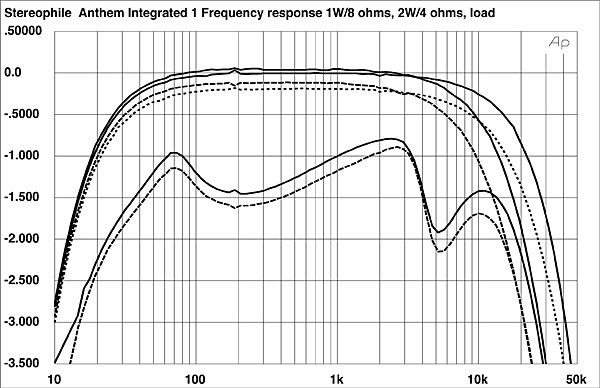
The Anthem's reproduction of a 10kHz squarewave (fig.2) shows the rounded leading edges due to the ultrasonic bandwidth but is free from signs of instability..
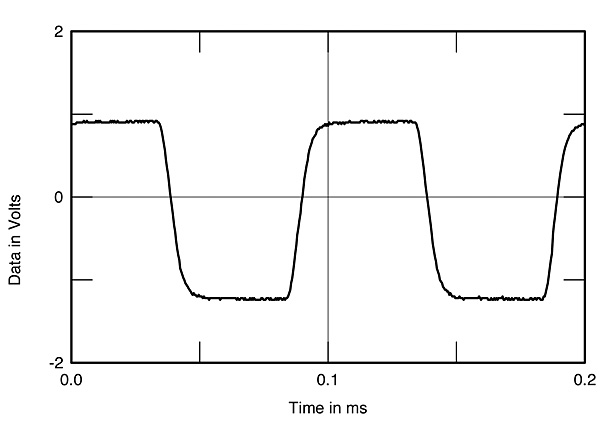
The Anthem's phono-stage RIAA accuracy (fig.3) was good, but with steep rolloffs at the edges of the audioband. The bass rolloff will protect your system from low-frequency record warp and some turntable noise.
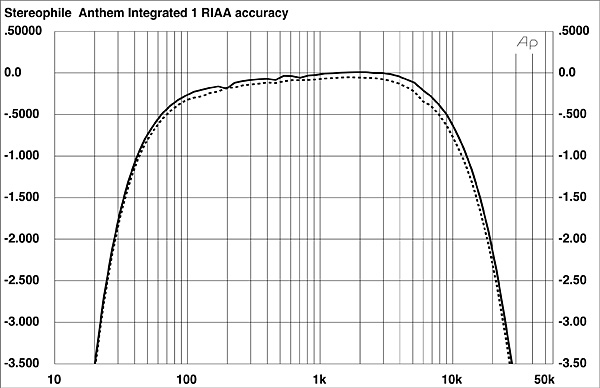
Fig.4 shows the Integrated 1's channel separation. The crosstalk is reasonably low in both directions, but we can see a fair amount of 120Hz power-supply noise in the audio output—a phenomenon suggested earlier in the noise measurements with and without a weighting filter.
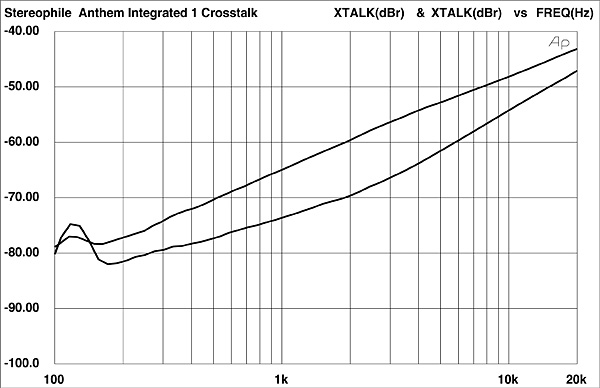
Fig.5 is the Integrated 1's THD+N vs frequency plots at 1W into 8 ohms, 2W into 4 ohms, and 4W into 2 ohms. The overall distortion is fairly high at low frequencies when driving 2 ohms, but is less than 0.1% through most of the band into 8 ohms or 4 ohms. Most users won't choose a loudspeaker with impedance dips to 2 ohms for the Integrated 1.
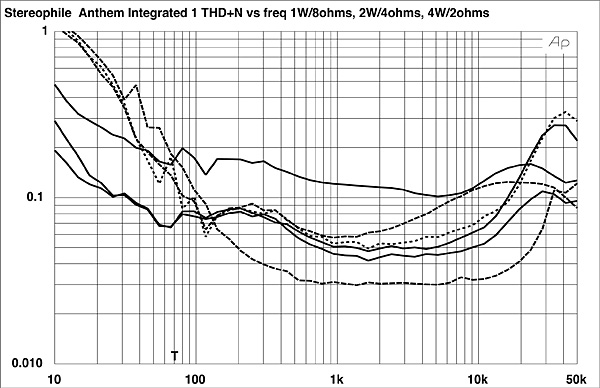
The nature of that distortion is predominantly third-harmonic, as shown by fig.6 (lower trace), though this is obscured by the noise in this plot. The Integrated 1's output spectrum when amplifying a 50Hz sinewave at 17W into 4 ohms is shown in fig.7. The second and third harmonics are the highest in level (reaching the –60dB horizontal division), as is typical for a tubed amplifier. When reproducing a combination of 19kHz and 20kHz at 17W into 4 ohms, the Integrated 1 produced the intermodulation distortion spectrum of fig.8. This is a rather high number of artifacts compared with the Linn and Rotel amplifiers that I review elsewhere in this issue.
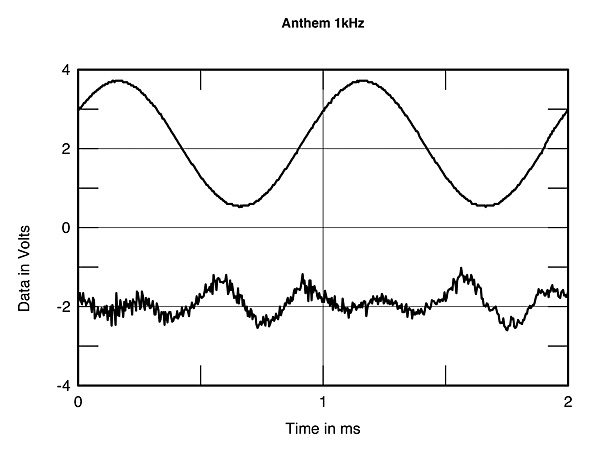
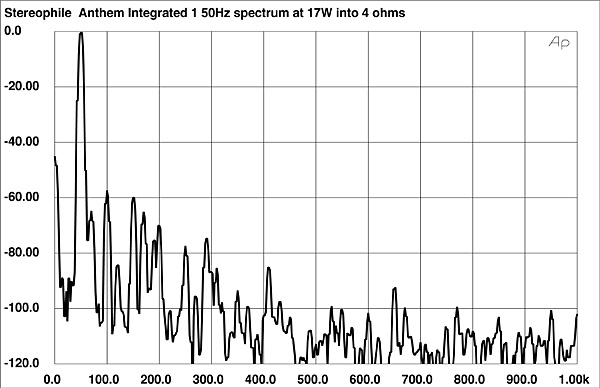
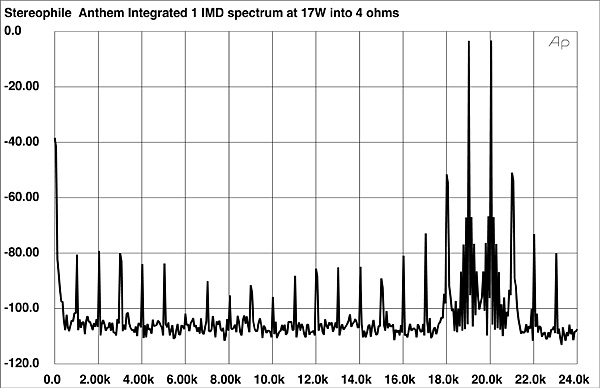
Fig.9 shows how the Integrated 1's THD+Noise varies with output power into 8 ohms, 4 ohms, and 2 ohms at 1kHz with one channel driven. The clipping points, shown in the table, are greater than 40W into 8 ohms and 4 ohms, suggesting that the Integrated 1's 25Wpc rating is conservative.—Robert Harley
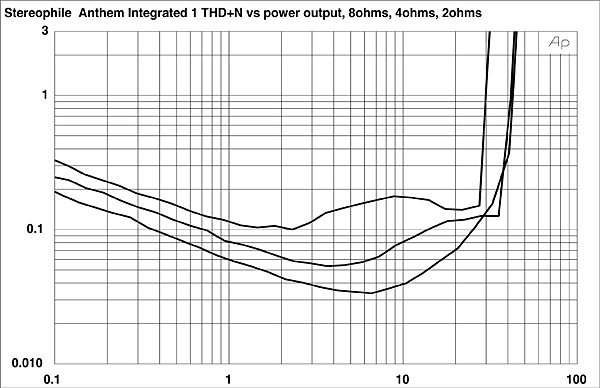
Table: Clipping: 1% THD+N at 1kHz
| Both channels driven (dBW) | One channel driven | ||
| Load | Left | Right | |
| 8 ohms | 43W (16.3dBW) | 42W (16.2dBW) | 43W (16.3dBW) |
| 4 ohms | 39W (12.9dBW) | 39W (12.9dBW) | 42W (13.2dBW) |
| 2 ohms | 30W (8.8dBW) | ||
AC Line voltage: 119V

Pretty basic looking compared to Anthem's usual rather high spec cosmetics.

...... three-dimensional presentation infused with air and bloom. " qtd Robert Harley.
Is this WHAT we would enjoy in a live concert: spacious, 3-D presentation....??? For lousy $1,500, should we still demand for more ??
Anything else, e.g.bass/mid/treble hi or low is personal subjective choice & is therefore of less priority.
OnLY ALL-tubed amps can deliver such closer-to-live music enjoyment at home for genuine music lovers, like your truly.
Of course, there are still room to improve the sonic performane of this $1,500 intergrated all-tube amp if I were to upgrade its exisiting design for MY own musical enjoyment. I'd done so with my vintage Dynaco ST-70 power amp with flying colours.
But this is a commercial product. The manufacturer got to make sure it is sellable in the marketplace.
Jack L